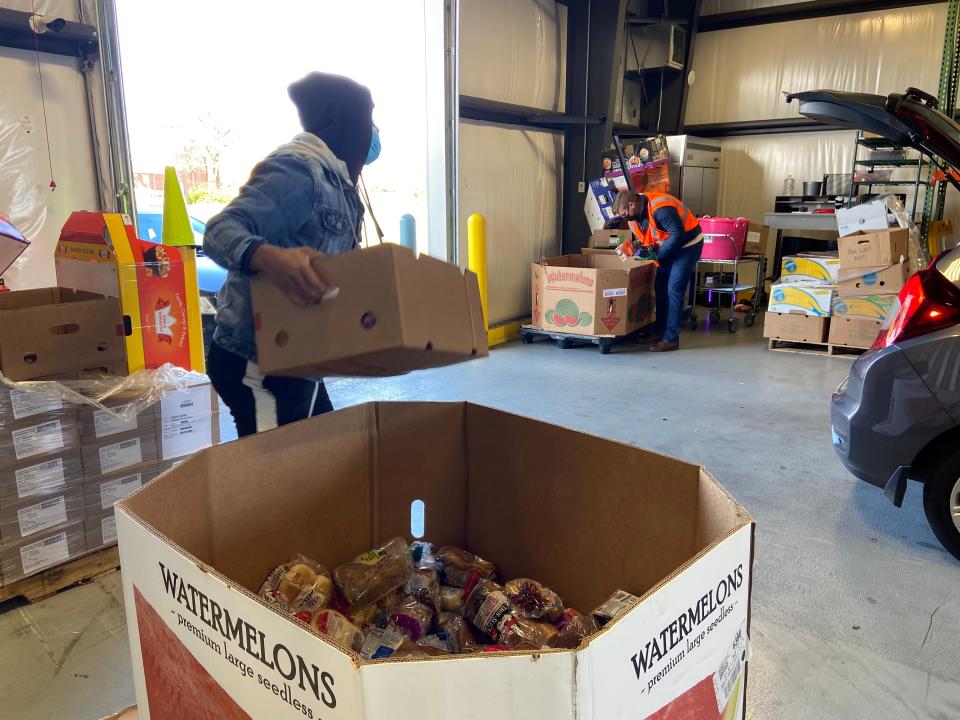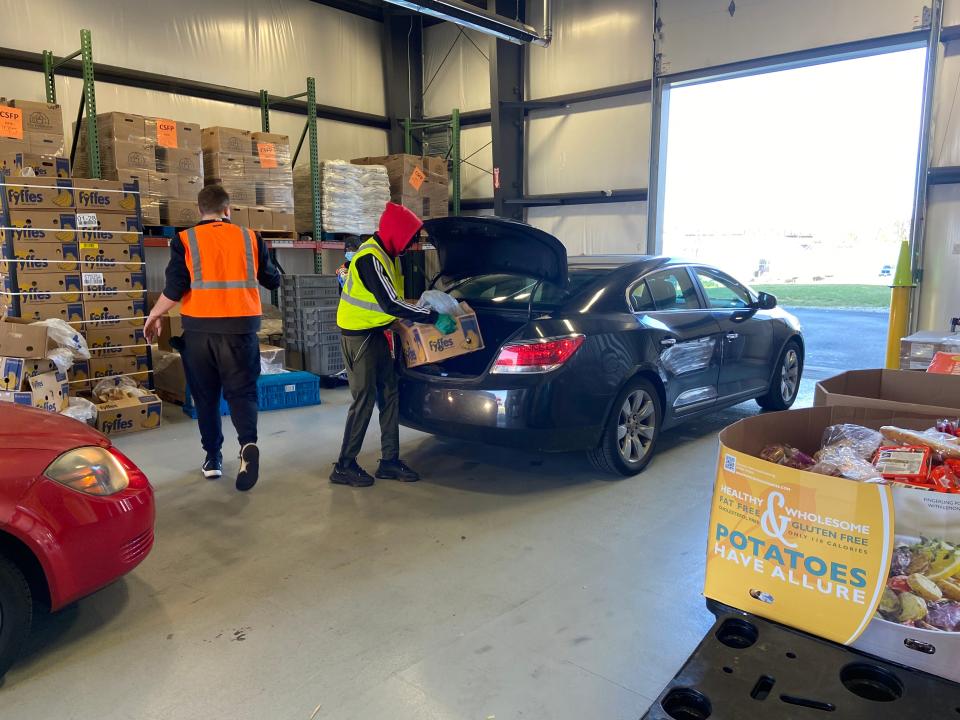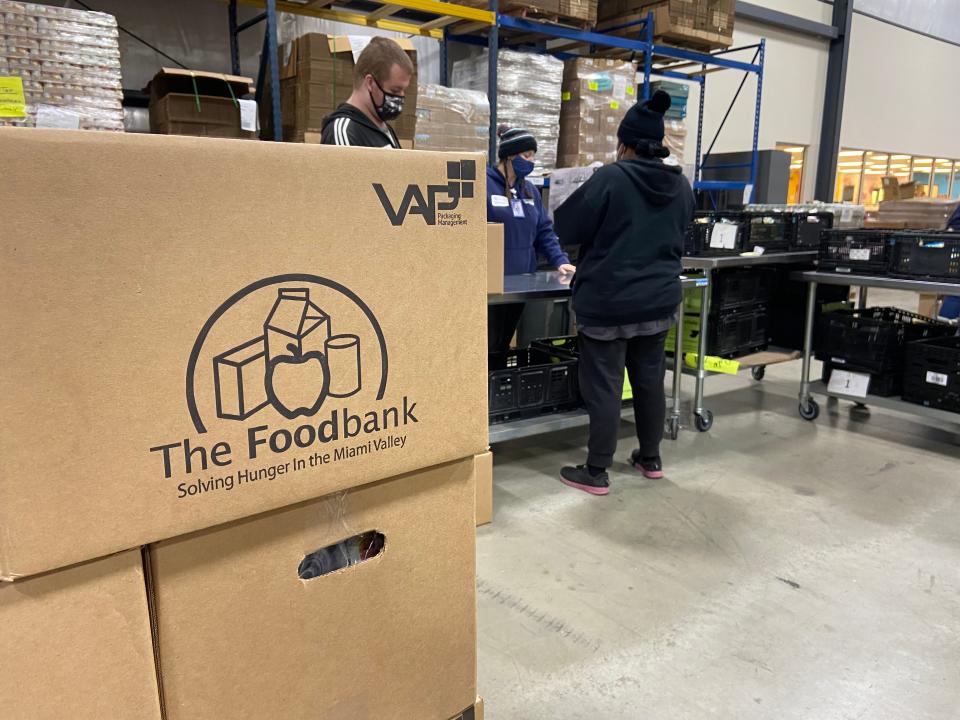Food banks adapt to meet rising need amid inflation, supply chain woes
While consumers are navigating higher prices on essentials like gas and groceries, the nation’s food banks and the food pantries they supply are being hit with a one-two punch of increased demand and rising costs.
At God’s Pantry Food Bank based in Lexington, Kentucky, both the demand for and the cost of their annual Thanksgiving food boxes are up this year.
“This year, we are increasing our distribution by 11% to 6,450 households,” said CEO Michael Halligan. “The cost of the food has gone up 14.5%.”
The food bank distributes more than 40 million pounds of food annually across 50 counties in Central and Eastern Kentucky.
They’re able to meet the demand for now – thanks in part to increased supply from government programs and continued support from donors – but if inflation, demand and supply chain issues continue to pile on, there could come a breaking point.
►Thanksgiving dinner: How are inflation and higher grocery prices affecting your holiday meal?

With prices rising just as some COVID-19-related safety nets are being yanked away, the number of families in need of emergency food services has surpassed the normal holiday season rush food banks are used to.
U.S. consumer prices spiked 6.2% in the past year, the largest 12-month increase since 1990. The Midwest and the South have been hit the hardest by inflation with a 6.6% increase from last year.
Food prices specifically are up 5.4% with the price of meat, poultry, fish and eggs up 11.9% from a year ago.
The pandemic created the perfect storm, according to Vince Hall, chief government relations officer for Feeding America, a national nonprofit network of 200 food banks. Normally, when there is a natural disaster in one place, unaffected food banks come to the aid of those in the area that was hit, he explained.
“COVID has been a 50-state hurricane. It has been affecting all of our member food banks and all 60,000 faith-based and charitable food distribution partners that we work with.”

COVID-19 impact creates more demand
On the morning of Nov. 15, a steady stream of cars arrived at The Foodbank Inc. in Dayton, Ohio, for the twice-weekly drive-thru pickup. At times, the line extended past the end of the parking lot into the street, but it never got as long as the first few weeks of the pandemic when the cars stretched onto nearby Interstate 75. One day, 755 cars arrived, up from the pre-pandemic average of about 230.
Things stabilized once the federal government passed measures to aid those impacted by pandemic job and wage losses. As much of that aid expired this year and families watched the price to fill up the tank and the grocery cart skyrocket, more people have turned back to emergency food relief.
►Inflation surges to 31-year high: What the jump in consumer prices means for your pocketbook, Joe Biden's troubles
The Foodbank normally sees about a 4% increase in demand from October to November, according to CEO Michelle Riley, but this year it's up 6%.
Pandemic Unemployment Compensation, which was down to $300 per week, ended on Sept. 6 in states that hadn’t already ended it early, as did the Pandemic Unemployment Assistance extended to self-employed workers.
Pandemic-related Supplemental Nutrition Assistance Program benefits expired on Sept. 30. SNAP recipients have been getting a 15% boost since December of 2020. Fortunately, the Department of Agriculture recently updated the Thrifty Food Plan giving an upward adjustment to SNAP benefits that kicked in Oct. 1.
Food pantries still report an increase in demand the last 10 to 14 days of every month, Hall said, because the EBT electronic benefit transfer cards run out before hunger does.
Terri Lee’s been stretching her husband’s disability payments and SNAP benefits as far as they can go for years since he suffered a series of strokes and she became his full-time caregiver.
Even though she knew he wasn’t supposed to eat things like rice because of his diabetes, the resident of Whitehall, Ohio, couldn’t afford healthier options with $19-a-month from SNAP.
That benefit recently increased to $30 with the recalculation, but their food bill doubled due to inflation.
“The price of food is astronomical,” Lee said. “What I used to spend $50 in the month, I spend $100 on.”
A few months ago, at Kevin Lee’s doctor’s recommendation, they connected with the Mid-Ohio Food Collective’s Farmacy program and then with the HEART food pantry, which offered to deliver since the couple doesn’t have a vehicle.

Now that they’re able to get fresh produce delivered once a week, Terri Lee said Kevin’s sugar and A1C have both gone down, something he hadn’t been able to achieve with expensive insulin and medications alone.
“It helps immensely,” Lee said. “Not only do they deliver the produce, but they also deliver dairy to us and they deliver meat and cereal.”
►When the benefits end: More Americans struggling to put food on the table after federal benefits end
► Inflation's wrath hits home: Families struggle to cope amid surging childcare costs
The Dayton foodbank is no stranger to increased demand. They kept the drive-thru open six days a week in the aftermath of a tornado outbreak on Memorial Day 2019 that wiped out nearly every home in the two zip codes they serve.
But the disaster also led to more giving, Riley said. They saw a record year for giving in 2019 that didn’t drop off when the pandemic hit. In fact, many people forwarded their stimulus checks to the food bank.
God’s Pantry gained about 3,000 new donors over the past year, Halligan said.
“And many of the donations that we got, particularly from first-time donors, were $1,200,” he said.
Inflation's impact: Rising prices to feed America
That extra generosity is making a big difference as foodbanks are forced to buy more food at higher prices today.
Food banks typically procure food in four ways – government programs that buy excess commodities from producers, donations of excess food from other parts of the supply chain like grocery stores, donations of food from the community via food drives, and purchasing food with money from charitable donations.
The government is actually pitching in more right now because Congress included increased funding for emergency food in the various COVID-19 relief laws that it passed, Halligan said. Feeding America is pushing for an additional $900 million for food purchases through The Emergency Food Assistance Program as some of those funding sources will run out next year.
►White House: To end inflation we must solve pandemic, supply chains
►'Invest in inflation': As costs soar, putting more money into stocks may be good for your 401(k)
Donations from wholesalers and grocery chains are slightly down, Halligan said. Stores are facing their own supply chain woes and therefore aren’t always able to donate the same items in the same amounts they normally would.
Food banks are relying more on purchasing food and inflation has a big impact on what they are paying.
“We purchase roughly a third of the produce that we distribute,” Halligan said. The cost of that produce is up 50% from the same time last year.
“Part of that is the transportation costs,” he said. “To get it here, our transportation costs are double what they were a year ago.”
God’s Pantry is paying more to gas up its own trucks for distribution to pantries, and increased wages for its drivers to compete with the nationwide shortage.
What can you do to help?
Food banks said all help is always welcome including donations of food or money.
“We actually see elevated demand twice a year. We see it during the holiday season, and we also see it when school is getting out,” Halligan said. “So any time of year is a good time of year for someone who has the financial means to make a monetary contribution.”
But what they really could use now is your muscle.
Volunteer programs were vastly scrapped when the pandemic hit to avoid spreading COVID-19.
The Foodbank in Dayton had 32 National Guard members helping when they lost their volunteers at the start of the pandemic. Now they’re operating without their normal flow of volunteers from drug treatment programs in the area. Halligan said the Kentucky food banks also have not gotten back to pre-pandemic volunteer levels.
“Volunteers are actually critically important to us right now,” Halligan said. “We have been operating without volunteers for most of the pandemic, or at least on a very reduced scale.”
Follow Katie Wedell on Twitter @KatieWedell and Facebook: facebook.com/ByKatieWedell
This article originally appeared on USA TODAY: Food banks adapt amid inflation, supply chain woes

 Yahoo Sports
Yahoo Sports 